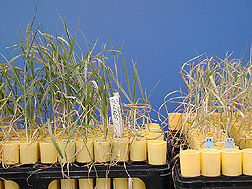| 
Click image for caption and other photo
information.
Read the
magazine
story to find out more.
|
New,
Salt-Tolerant Plants Developed
By Marcia Wood
January 29, 2003 Two new lines of salt-tolerant
plants, boasting genes from wheat and a wild relative called wheatgrass, may
someday prove to be a boon for wheat growers. Salt tolerance in plants is a
prized trait, according to Agricultural
Research Service research geneticist Richard R.-C. Wang. He developed the
new plants, known simply as W4909 and W4910, at ARS'
Forage and Range Research
Laboratory in Logan, Utah.
Salt tolerance is especially valuable in the irrigated wheat producing
regions of the American West, where irrigation can accelerate buildup of salts.
Salinity weakens or kills plants. Nationwide, it's blamed for reducing crop
yields by about 25 percent.
Wang's research has already attracted the attention of scientists and plant
breeders throughout the United States and from several other nations as well.
He is working to demystify the complicated genetics of rangeland plants,
including wheatgrass. The goal? -- Develop hardier, more nutritious rangeland
forages for cattle, other livestock and wildlife. These improved plants also
could be used to revegetate roadsides, burned sites or erosion-prone slopes.
W4909 and W4910 contain salt-tolerance genes from wheatgrass and what's
known as a Ph-inhibitor gene. Presence of the inhibitor gene allows plant
geneticists to move the salt-tolerance genes among domestic wheats. Normally, a
gene called Ph1b would thwart that exchange.
For the research, Wang collaborated with ARS geneticist Steven R. Larson of
the Logan team; Catherine M. Grieve, a plant physiologist at the agency's
George E. Brown, Jr., Salinity
Laboratory at Riverside, Calif.; Michael C. Shannon, formerly at Riverside
and now with ARS' Pacific West Area Office, Albany, Calif.; Abdul Mujeeb-Kazi
of the International Maize and Wheat Improvement Center; and four visiting
scientists from China -- Zanmin Hu, Xiaomei Li, Jiyi Zhang and Xueyong Zhang.
Wang and his co-investigators are the first to use the Ph1b gene-inhibition
technology to incorporate, into wheat genetic material, genes borrowed from
another plant species. Details are in the
January
issue of ARS' Agricultural Research magazine.
ARS is the U.S. Department of
Agriculture's chief scientific research agency.
|